A Complete Picture of the CYP2D6 Heterogeneity in Northeastern Italian Genetic Isolates
Abstract
1. Introduction
2. Results
3. Discussion
4. Materials and Methods
4.1. Cohort Selection and Genetic Analysis
4.2. Activity Score and Metabolizer Status
- Not defined: carrying at least one allele with an unknown function;
- UM: activity score equal to or above 2.5;
- NM: activity score between 1.25 and 2.25 inclusive;
- IM: activity score between 0.25 and 1 inclusive;
- PM: activity score equal to 0.
Supplementary Materials
Author Contributions
Funding
Institutional Review Board Statement
Informed Consent Statement
Data Availability Statement
Conflicts of Interest
References
- Brlek, P.; Bulić, L.; Bračić, M.; Projić, P.; Škaro, V.; Shah, N.; Shah, P.; Primorac, D. Implementing Whole Genome Sequencing (WGS) in Clinical Practice: Advantages, Challenges, and Future Perspectives. Cells 2024, 13, 504. [Google Scholar] [CrossRef]
- Floris, M.; Moschella, A.; Alcalay, M.; Montella, A.; Tirelli, M.; Fontana, L.; Idda, M.L.; Guarnieri, P.; Capasso, M.; Mammì, C.; et al. Pharmacogenetics in Italy: Current Landscape and Future Prospects. Hum. Genom. 2024, 18, 78. [Google Scholar] [CrossRef]
- Mackley, M.P.; Fletcher, B.; Parker, M.; Watkins, H.; Ormondroyd, E. Stakeholder Views on Secondary Findings in Whole-Genome and Whole-Exome Sequencing: A Systematic Review of Quantitative and Qualitative Studies. Genet. Med. 2017, 19, 283–293. [Google Scholar] [CrossRef] [PubMed]
- Swen, J.J.; van der Wouden, C.H.; Manson, L.E.; Abdullah-Koolmees, H.; Blagec, K.; Blagus, T.; Böhringer, S.; Cambon-Thomsen, A.; Cecchin, E.; Cheung, K.C.; et al. A 12-Gene Pharmacogenetic Panel to Prevent Adverse Drug Reactions: An Open-Label, Multicentre, Controlled, Cluster-Randomised Crossover Implementation Study. Lancet 2023, 401, 347–356. [Google Scholar] [CrossRef]
- Shaman, J.A.; Bousman, C.A.; Mitropoulou, C.; Padmanabhan, S. Editorial: Pharmacogenomics: From Bench to Bedside and Back Again. Front. Genet. 2022, 13, 878191. [Google Scholar] [CrossRef] [PubMed]
- Bousman, C.A.; Stevenson, J.M.; Ramsey, L.B.; Sangkuhl, K.; Hicks, J.K.; Strawn, J.R.; Singh, A.B.; Ruaño, G.; Mueller, D.J.; Tsermpini, E.E.; et al. Clinical Pharmacogenetics Implementation Consortium (CPIC) Guideline for CYP2D6, CYP2C19, CYP2B6, SLC6A4, and HTR2A Genotypes and Serotonin Reuptake Inhibitor Antidepressants. Clin. Pharmacol. Ther. 2023, 114, 51–68. [Google Scholar] [CrossRef] [PubMed]
- Gaedigk, A.; Casey, S.T.; Whirl-Carrillo, M.; Miller, N.A.; Klein, T.E. Pharmacogene Variation Consortium: A Global Resource and Repository for Pharmacogene Variation. Clin. Pharmacol. Ther. 2021, 110, 542–545. [Google Scholar] [CrossRef]
- Nofziger, C.; Turner, A.J.; Sangkuhl, K.; Whirl-Carrillo, M.; Agúndez, J.A.G.; Black, J.L.; Dunnenberger, H.M.; Ruano, G.; Kennedy, M.A.; Phillips, M.S.; et al. PharmVar GeneFocus: CYP2D6. Clin. Pharmacol. Ther. 2020, 107, 154–170. [Google Scholar] [CrossRef]
- Chen, X.; Shen, F.; Gonzaludo, N.; Malhotra, A.; Rogert, C.; Taft, R.J.; Bentley, D.R.; Eberle, M.A. Cyrius: Accurate CYP2D6 Genotyping Using Whole-Genome Sequencing Data. Pharmacogenomics J. 2021, 21, 251–261. [Google Scholar] [CrossRef]
- Whirl-Carrillo, M.; Huddart, R.; Gong, L.; Sangkuhl, K.; Thorn, C.F.; Whaley, R.; Klein, T.E. An Evidence-Based Framework for Evaluating Pharmacogenomics Knowledge for Personalized Medicine. Clin. Pharmacol. Ther. 2021, 110, 563–572. [Google Scholar] [CrossRef]
- Debbie Kennett International Society of Genetic Genealogy. Available online: https://isogg.org/wiki/Autosomal_DNA_statistics (accessed on 11 April 2025).
- Huddart, R.; Fohner, A.E.; Whirl-Carrillo, M.; Wojcik, G.L.; Gignoux, C.R.; Popejoy, A.B.; Bustamante, C.D.; Altman, R.B.; Klein, T.E. Standardized Biogeographic Grouping System for Annotating Populations in Pharmacogenetic Research. Clin. Pharmacol. Ther. 2019, 105, 1256–1262. [Google Scholar] [CrossRef]
- Baltzer Houlind, M.; Hansen, L.; Iversen, E.; Rasmussen, H.B.; Larsen, J.B.; Jørgensen, S.; Dalhoff, K.; Damkier, P.; Walls, A.B.; Vermehren, C.; et al. Pharmacogenetic Testing of CYP2D6, CYP2C19 and CYP2C9 in Denmark: Agreement between Publicly Funded Genotyping Tests and the Subsequent Phenotype Classification. Basic Clin. Pharmacol. Toxicol. 2024, 134, 756–763. [Google Scholar] [CrossRef]
- U.S. Food & Drug Administration. Table of Pharmacogenetic Associations. Available online: https://www.fda.gov/medical-devices/precision-medicine/table-pharmacogenetic-associations#resources (accessed on 11 April 2025).
- Duarte, J.D.; Thomas, C.D.; Lee, C.R.; Huddart, R.; Agundez, J.A.G.; Baye, J.F.; Gaedigk, A.; Klein, T.E.; Lanfear, D.E.; Monte, A.A.; et al. Clinical Pharmacogenetics Implementation Consortium Guideline (CPIC) for CYP2D6, ADRB1, ADRB2, ADRA2C, GRK4, and GRK5 Genotypes and Beta-Blocker Therapy. Clin. Pharmacol. Ther. 2024, 116, 939–947. [Google Scholar] [CrossRef]
- Nofziger, C.; Paulmichl, M. Accurately Genotyping CYP2D6: Not for the Faint of Heart. Pharmacogenomics 2018, 19, 999–1002. [Google Scholar] [CrossRef]
- Muroi, Y.; Saito, T.; Takahashi, M.; Sakuyama, K.; Niinuma, Y.; Ito, M.; Tsukada, C.; Ohta, K.; Endo, Y.; Oda, A.; et al. Functional Characterization of Wild-Type and 49 CYP2D6 Allelic Variants for N-Desmethyltamoxifen 4-Hydroxylation Activity. Drug Metab. Pharmacokinet. 2014, 29, 360–366. [Google Scholar] [CrossRef]
- Grzegorzewski, J.; Brandhorst, J.; König, M. Physiologically Based Pharmacokinetic (PBPK) Modeling of the Role of CYP2D6 Polymorphism for Metabolic Phenotyping with Dextromethorphan. Front. Pharmacol. 2022, 13, 1029073. [Google Scholar] [CrossRef]
- Esko, T.; Mezzavilla, M.; Nelis, M.; Borel, C.; Debniak, T.; Jakkula, E.; Julia, A.; Karachanak, S.; Khrunin, A.; Kisfali, P.; et al. Genetic Characterization of Northeastern Italian Population Isolates in the Context of Broader European Genetic Diversity. Eur. J. Hum. Genet. 2013, 21, 659–665. [Google Scholar] [CrossRef]
- Chen, S.; Zhou, Y.; Chen, Y.; Gu, J. Fastp: An Ultra-Fast All-in-One FASTQ Preprocessor. Bioinformatics 2018, 34, i884–i890. [Google Scholar] [CrossRef] [PubMed]
- Simon, A.; Laura, B.; Sarah, I.; Hayley, C.; Jo, M. Babraham Bioinformatics. Available online: https://www.bioinformatics.babraham.ac.uk/projects/fastqc/ (accessed on 11 April 2025).
- Li, H.; Durbin, R. Fast and accurate short read alignment with Burrows-Wheeler transform. Bioinformatics 2009, 25, 1754–1760. [Google Scholar] [CrossRef] [PubMed] [PubMed Central]
- Tarasov, A.; Vilella, A.J.; Cuppen, E.; Nijman, I.J.; Prins, P. Sambamba: Fast Processing of NGS Alignment Formats. Bioinformatics 2015, 31, 2032–2034. [Google Scholar] [CrossRef] [PubMed]
- Depristo, M.A.; Banks, E.; Poplin, R.; Garimella, K.V.; Maguire, J.R.; Hartl, C.; Philippakis, A.A.; Del Angel, G.; Rivas, M.A.; Hanna, M.; et al. A Framework for Variation Discovery and Genotyping Using Next-Generation DNA Sequencing Data. Nature Genet. 2011, 43, 491–498. [Google Scholar] [CrossRef]
- Purcell, S.; Neale, B.; Todd-Brown, K.; Thomas, L.; Ferreira, M.A.R.; Bender, D.; Maller, J.; Sklar, P.; De Bakker, P.I.W.; Daly, M.J.; et al. PLINK: A Tool Set for Whole-Genome Association and Population-Based Linkage Analyses. Am. J. Hum. Genet. 2007, 81, 559–575. [Google Scholar] [CrossRef] [PubMed]
- Excoffier, L.; Smouse, P.E.; Quattro, J.M. Analysis of Molecular Variance Inferred from Metric Distances among DNA Haplotypes: Application to Human Mitochondrial DNA Restriction Data. Genetics 1992, 131, 479–491. [Google Scholar] [CrossRef] [PubMed]
- Weir, B.S.; Cockerham, C.C. Estimating F-Statistics For the Analysis of Population Structure. Evolution 1984, 38, 1358–1370. [Google Scholar] [CrossRef] [PubMed]
- Goudet, J. HIERFSTAT, a Package for R to Compute and Test Hierarchical F-Statistics. Mol. Ecol. Notes 2005, 5, 184–186. [Google Scholar] [CrossRef]
- Gaedigk, A.; Dinh, J.C.; Jeong, H.; Prasad, B.; Leeder, J.S. Ten Years’ Experience with the CYP2D6 Activity Score: A Perspective on Future Investigations to Improve Clinical Predictions for Precision Therapeutics. J. Pers. Med. 2018, 8, 15. [Google Scholar] [CrossRef]
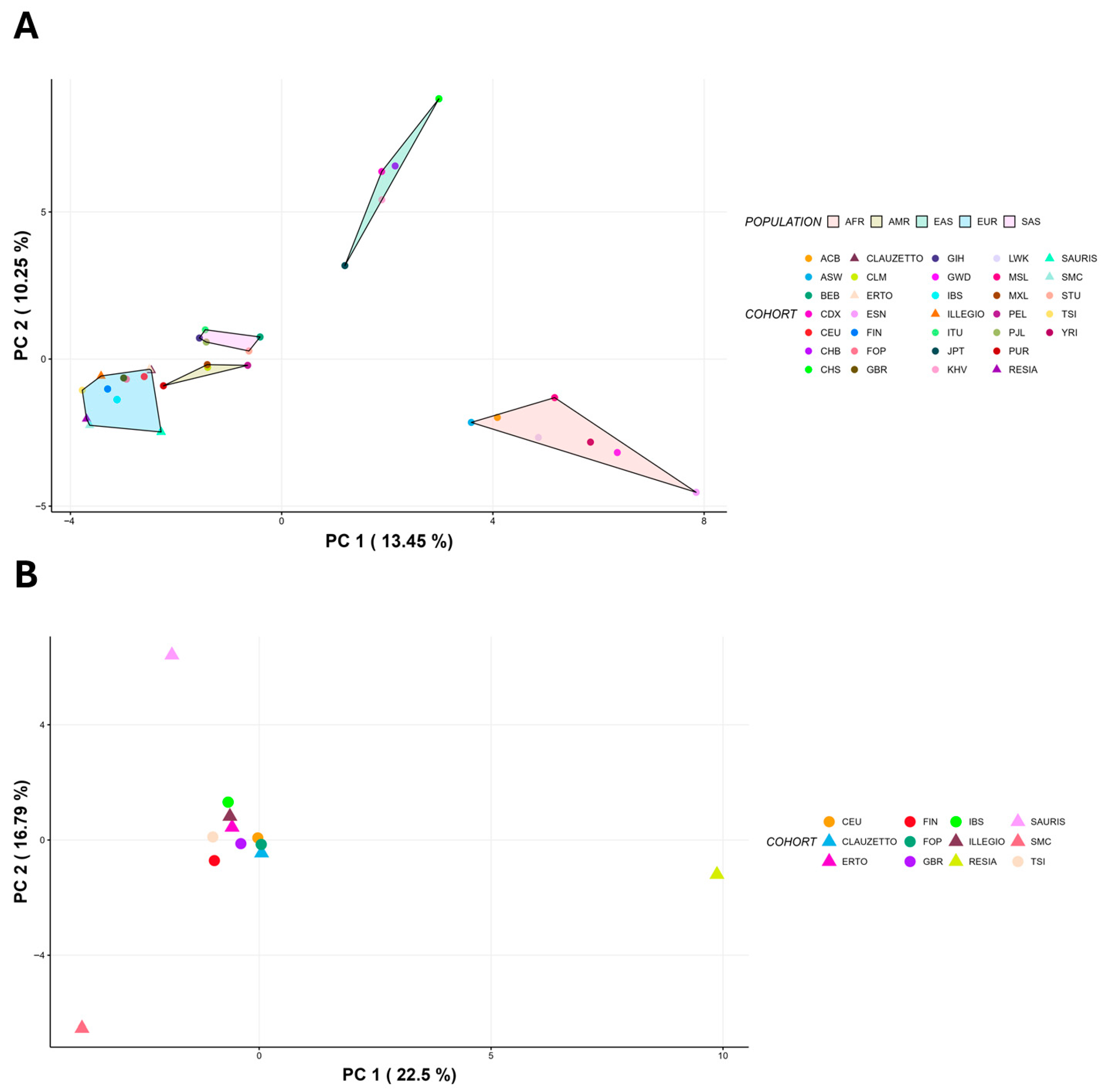
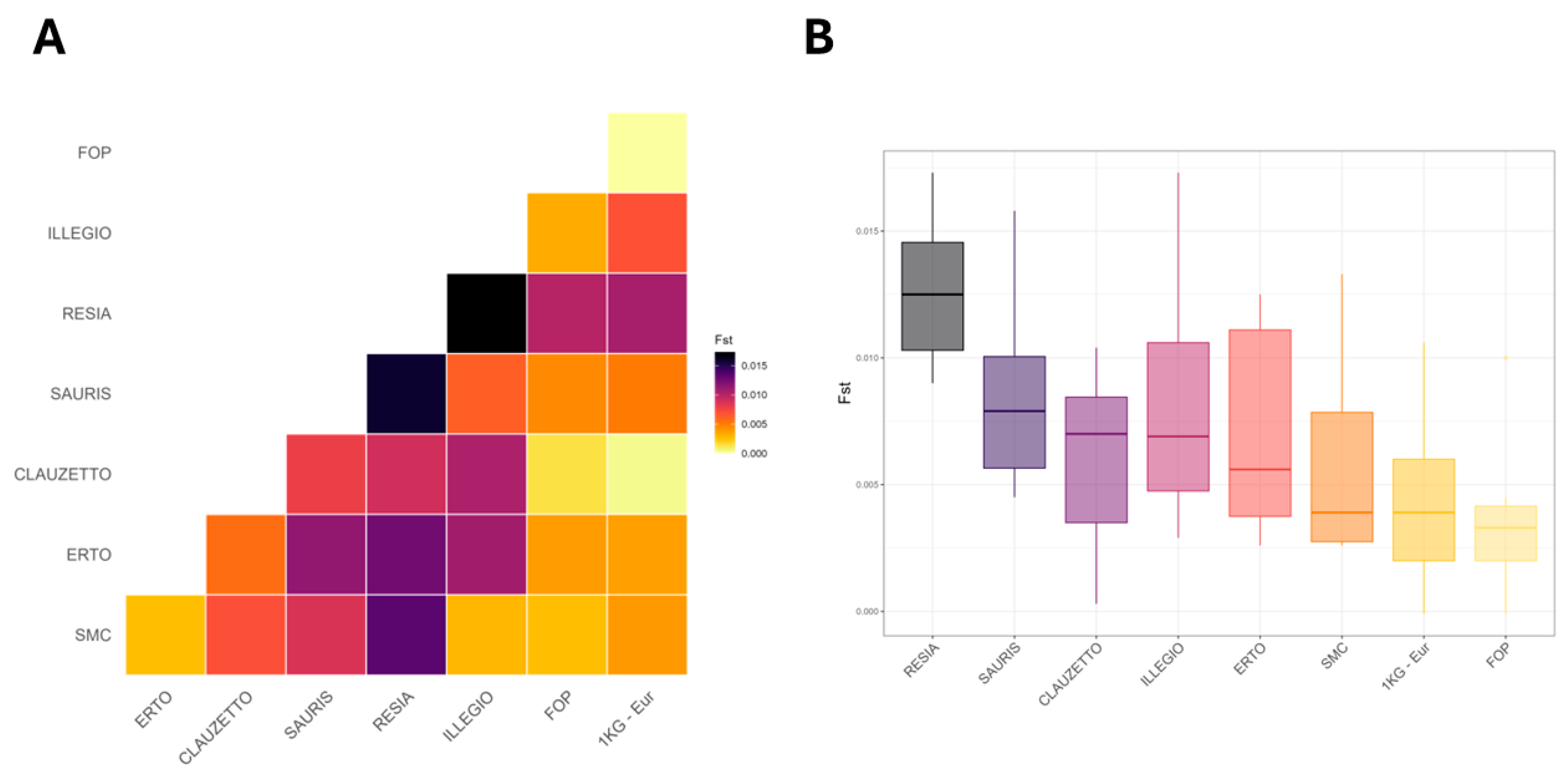
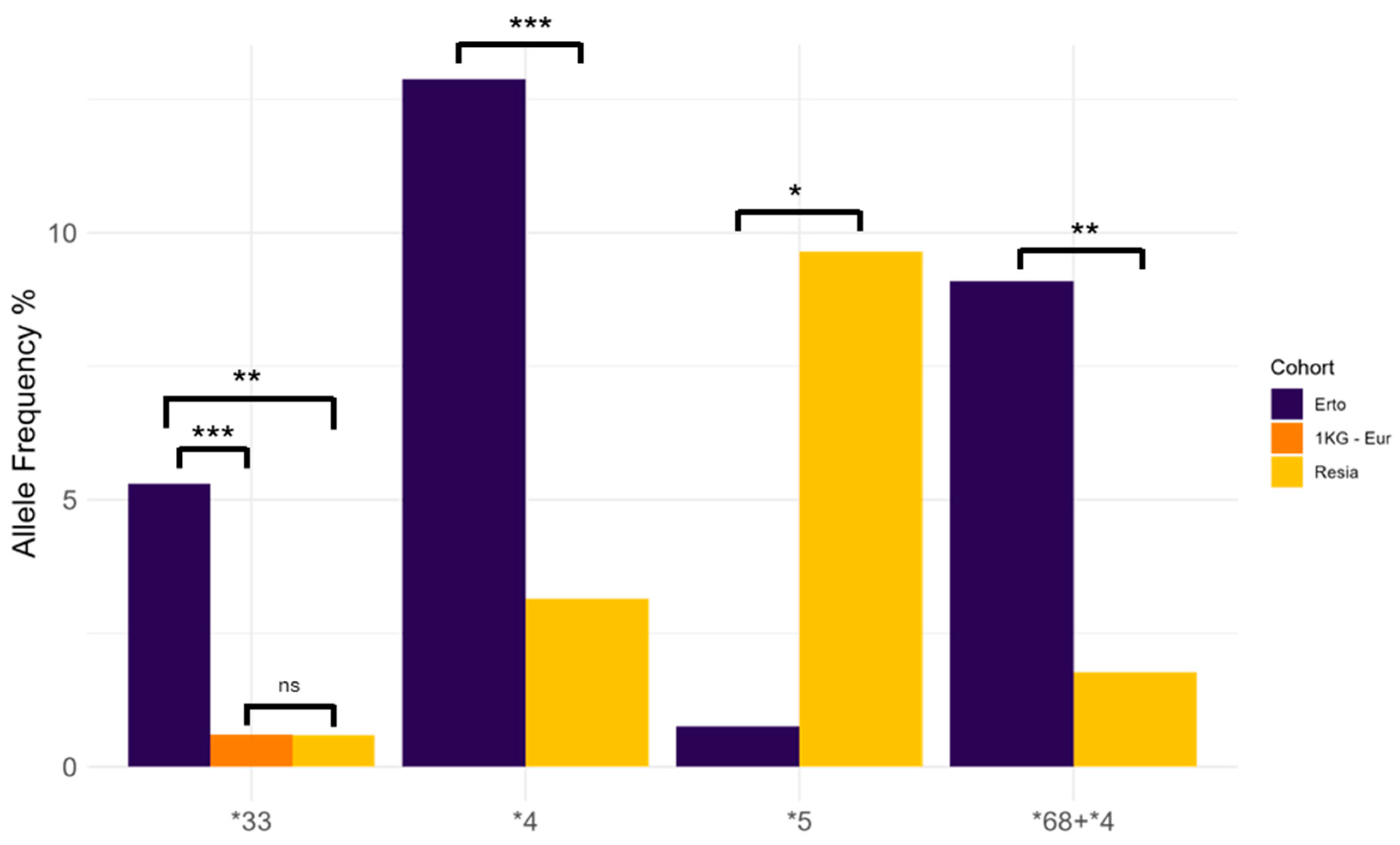
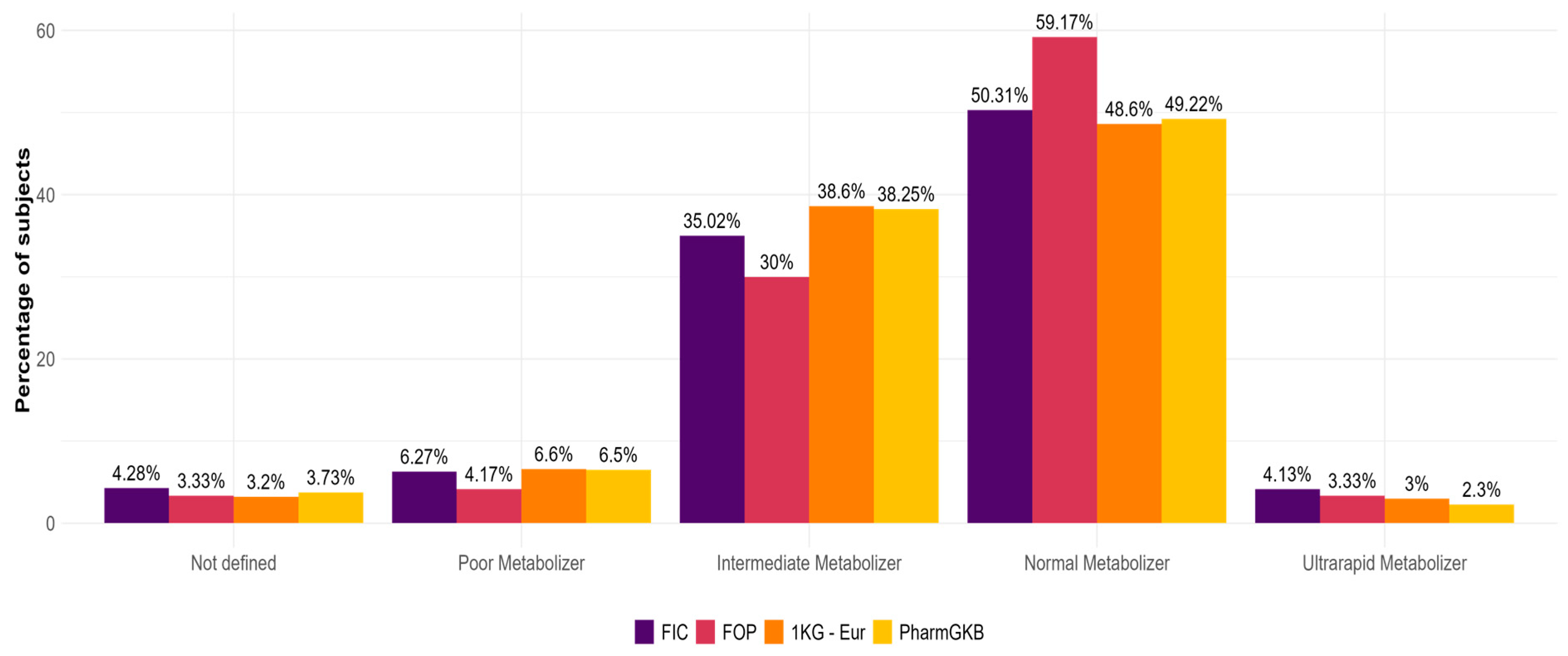
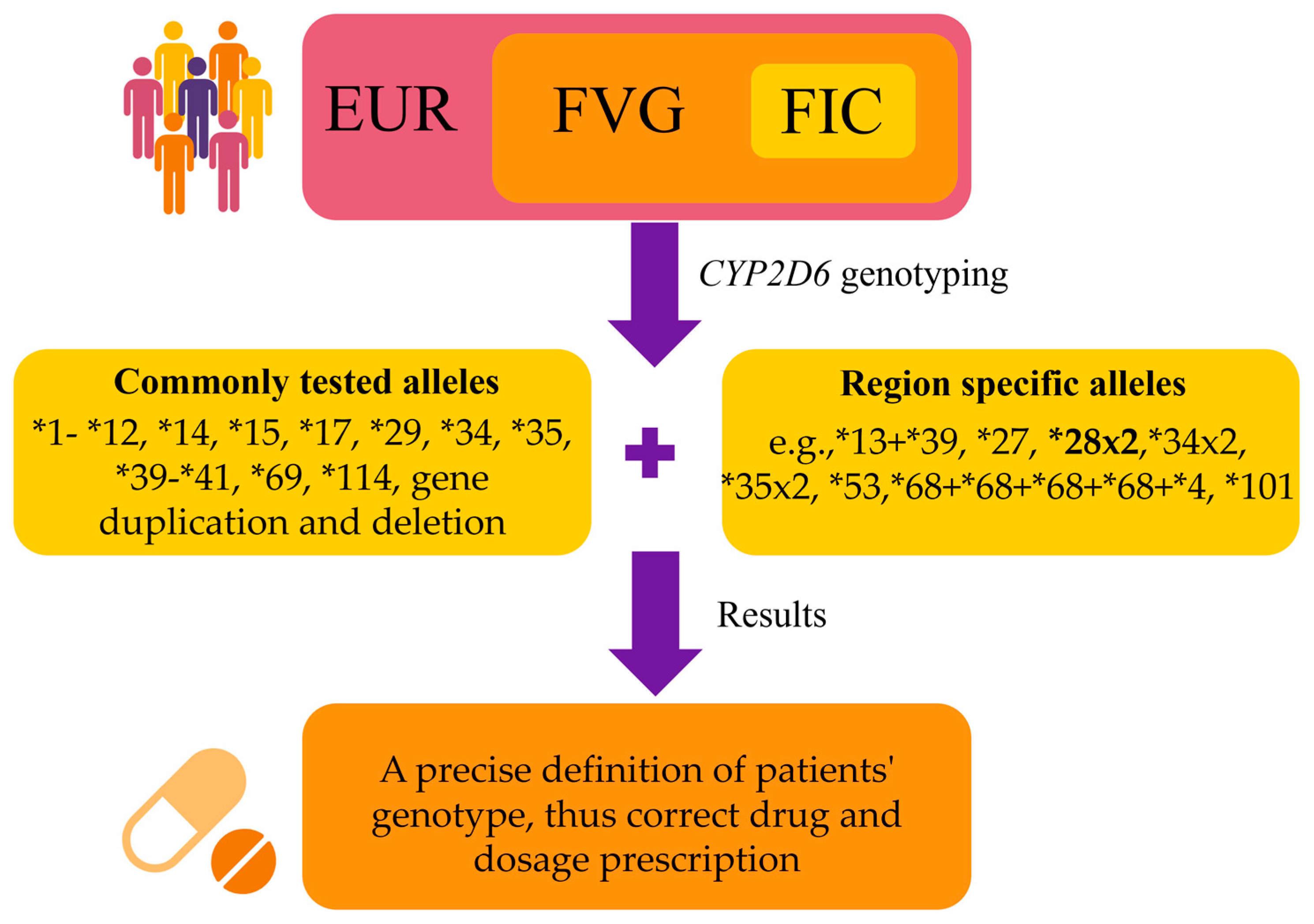
| Allele | Function | AC in FIC | Population with the Highest AF (PHAF) | AF in the PHAF |
|---|---|---|---|---|
| *1x3 | Increased | 1 | Sub-Saharan African | 0.002 |
| *1x4 | Increased | 1 | Sub-Saharan African | 0.002 |
| *4.013 | No function | 1 | NA | NA |
| *6x2 | No function | 1 | Latino | 0.00011035591 |
| *13+*39 | Normal | 1 | NA | NA |
| *27 | Normal | 1 | Sub-Saharan African | 0.0033542388 |
| *28x2 | Unknown | 13 | NA | NA |
| *34 | Normal | 1 | European | 0.010744718 |
| *34x2 | Unknown | 1 | NA | NA |
| *35x2 | Increased | 1 | Latino | 0.00093648373 |
| *39 | Normal | 1 | Near Eastern | 0.026844444 |
| *41x2 | Decreased | 2 | Near Eastern | 0.004381261 |
| *53 | Normal | 1 | Latino | 0.005 |
| *68+*68+*68+*68+*4 | No function | 1 | NA | NA |
| *74 | Unknown | 1 | Sub-Saharan African | 0.0013710798 |
| *101 | No function | 1 | Central/South Asian | 0.003 |
| *116 | Unknown | 1 | NA | NA |
| *121 | Unknown | 1 | African American/Afro-Caribbean | 0.003 |
| SMC | Illegio | Illegio | Illegio | Illegio | Illegio | Illegio | Resia | Resia | Resia | Resia | Resia | Resia | ||
| SUB1 | SUB2 | SUB3 | SUB4 | SUB5 | SUB6 | SUB7 | SUB8 | SUB9 | SUB10 | SUB11 | SUB12 | SUB13 | ||
| SMC | SUB1 | - | ||||||||||||
| Illegio | SUB2 | 0.0000 | - | |||||||||||
| Illegio | SUB3 | 0.0000 | 0.0000 | - | ||||||||||
| Illegio | SUB4 | 0.0000 | 0.0000 | 0.0406 | - | |||||||||
| Illegio | SUB5 | 0.0000 | 0.0000 | 0.0579 | 0.4850 | - | ||||||||
| Illegio | SUB6 | 0.0000 | 0.0000 | 0.0245 | 0.0227 | 0.0437 | - | |||||||
| Illegio | SUB7 | 0.0000 | 0.0000 | 0.0238 | 0.1435 | 0.2375 | 0.0398 | - | ||||||
| Resia | SUB8 | 0.0000 | 0.0000 | 0.0000 | 0.0000 | 0.0000 | 0.0000 | 0.0000 | - | |||||
| Resia | SUB9 | 0.0000 | 0.0000 | 0.0000 | 0.0000 | 0.0000 | 0.0000 | 0.0000 | 0.0411 | - | ||||
| Resia | SUB10 | 0.0000 | 0.0000 | 0.0000 | 0.0000 | 0.0000 | 0.0000 | 0.0000 | 0.0507 | 0.0000 | - | |||
| Resia | SUB11 | 0.0000 | 0.0000 | 0.0000 | 0.0000 | 0.0000 | 0.0000 | 0.0000 | 0.4710 | 0.0407 | 0.0310 | - | ||
| Resia | SUB12 | 0.0000 | 0.0000 | 0.0000 | 0.0000 | 0.0000 | 0.0000 | 0.0000 | 0.0619 | 0.0391 | 0.4853 | 0.0000 | - | |
| Resia | SUB13 | 0.0000 | 0.0000 | 0.0000 | 0.0000 | 0.0000 | 0.0000 | 0.0000 | 0.0000 | 0.0000 | 0.0000 | 0.0000 | 0.0000 | - |
Disclaimer/Publisher’s Note: The statements, opinions and data contained in all publications are solely those of the individual author(s) and contributor(s) and not of MDPI and/or the editor(s). MDPI and/or the editor(s) disclaim responsibility for any injury to people or property resulting from any ideas, methods, instructions or products referred to in the content. |
© 2025 by the authors. Licensee MDPI, Basel, Switzerland. This article is an open access article distributed under the terms and conditions of the Creative Commons Attribution (CC BY) license (https://creativecommons.org/licenses/by/4.0/).
Share and Cite
Tesolin, P.; Nardone, G.G.; Santin, A.; Pecori, A.; Ruberto, R.; Concas, M.P.; Zampieri, S.; Girotto, G. A Complete Picture of the CYP2D6 Heterogeneity in Northeastern Italian Genetic Isolates. Int. J. Mol. Sci. 2025, 26, 9445. https://doi.org/10.3390/ijms26199445
Tesolin P, Nardone GG, Santin A, Pecori A, Ruberto R, Concas MP, Zampieri S, Girotto G. A Complete Picture of the CYP2D6 Heterogeneity in Northeastern Italian Genetic Isolates. International Journal of Molecular Sciences. 2025; 26(19):9445. https://doi.org/10.3390/ijms26199445
Chicago/Turabian StyleTesolin, Paola, Giuseppe Giovanni Nardone, Aurora Santin, Alessandro Pecori, Romina Ruberto, Maria Pina Concas, Stefania Zampieri, and Giorgia Girotto. 2025. "A Complete Picture of the CYP2D6 Heterogeneity in Northeastern Italian Genetic Isolates" International Journal of Molecular Sciences 26, no. 19: 9445. https://doi.org/10.3390/ijms26199445
APA StyleTesolin, P., Nardone, G. G., Santin, A., Pecori, A., Ruberto, R., Concas, M. P., Zampieri, S., & Girotto, G. (2025). A Complete Picture of the CYP2D6 Heterogeneity in Northeastern Italian Genetic Isolates. International Journal of Molecular Sciences, 26(19), 9445. https://doi.org/10.3390/ijms26199445







